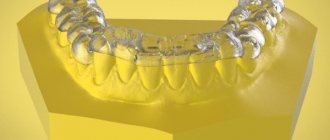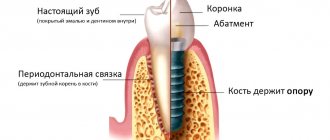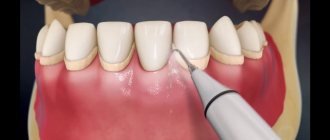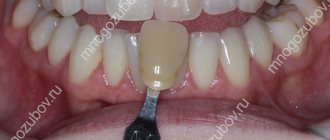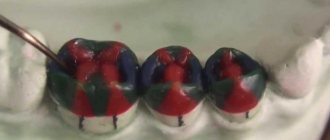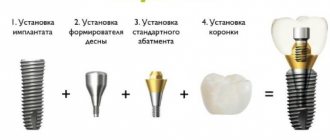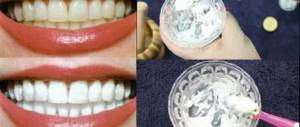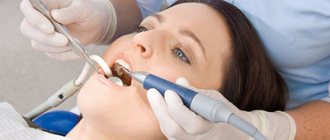7664
An impression or cast of teeth is necessary in the process of prosthetics of any elements of the dentition.
Also, orthodontics cannot do without the use of impressions when creating alignment or bite-correcting systems.
It is used to produce the most precise orthopedic and orthodontic devices.
general description
An impression is an impression of one or all elements of the dentition, according to which models of future designs for prosthetics are cast in laboratories.
The scope of application of impressions is orthopedic dentistry. When taking an impression, the specialist uses impression trays, as well as various types of materials - plaster, silicone, etc. Impressions are made before making corrective devices.
Casts are also used for aesthetic purposes, such as bleaching units. Silicone mouth guards are made based on tooth imprints, which are used to perform remineralization restoration of elements.
Using impressions, you can make a diagnostic model and determine the type of dental disease.
How much does dental prosthetics cost?
Taking impressions is a mandatory procedure before prosthetics, without which it is impossible to create orthopedic structures for installation. As a rule, this procedure is included in the total cost of prosthetics.
How much does it cost to get dentures?
, depends on various nuances: the type of orthopedic structure chosen for installation, the material for the impression, the complexity of the case and the individual tariffs of the dental center.
We have established affordable prices for prosthetics and dental implants. Medical and surgical procedures are performed by qualified dentists with extensive professional experience, using innovative techniques and high-quality materials from the world's best manufacturers.
How much does dental prosthetics cost:
- removable
dentures – from RUB 17,400; - dental crowns – from RUB 3,300;
- veneers – from 12,000 rubles;
- tabs – from 6500 rub.
More detailed information about prices and services of the center is available on the official website. All patients who leave their reviews on our website are guaranteed to receive a 3% discount on all types of dental services (this is additional and is added to the main discounts available to the client).
Types of impressions
Impressions are divided into anatomical and functional. In the first case, the construction is manufactured without taking into account the characteristics of the tissues that are located on the border of removable dentures.
In the process of creating functional structures, medical instruments are used, selected in accordance with the individual characteristics of the patient.
Due to this, the mobility of the soft tissue folds located on the border of the implantation bed is reflected on the impression. A functional impression is indicated for patients who have lost all or part of their teeth.
Functional type products are classified into types:
- Compression. Used to take an impression of the lower jaw.
The products reflect the relief of the base of the prosthesis and allow you to redistribute the load during chewing over a larger area of its base. Due to this property, premature atrophy of bone structures is prevented. To make a compression print, materials with high viscosity values are used. - Unloading. The base of the prosthesis made from the unloading cast will have the shape of uncompressed mucous membranes.
This type of device is recommended for people whose professional activities involve speaking. The load during chewing will be distributed unevenly due to the mismatch between the relief of the bone tissue and the base of the prosthesis. - Combined. Necessary for creating devices that compress the pliable and unload the sedentary areas of the mucous membranes of the mouth located in the prosthesis area.
Thanks to differentiated impressions, implants are created that provide an even load during chewing or speaking.
What are braces?
A special orthodontic device aimed at leveling malocclusion, eliminating spaces and gaps between teeth, as well as correcting the direction of their growth, is actually called braces.
The bracket system consists of the following elements:
- bracket - its material can be different;
- metal arc;
- fastening (ligature) - this part is not always present in the design.
Each brace looks like a small plate that is firmly attached to the tooth enamel and connected to the arch. The degree of arc tension is adjusted manually. By continuously applying pressure to the tooth, it moves into the desired position. The thicker the arch, the more pressure the structure exerts on the dentition.
In addition to orthodontic treatment of the dental system, modern youth perceives braces as a manifestation of individuality and self-expression.
Since wearing braces takes quite a long period, many patients strive to get a model that will be almost invisible or look like a decoration.
You can choose the bracket plate based on your own preferences or financial capabilities. The following options are available to choose from:
- plastic;
- metal;
- ceramic;
- sapphire;
- combined.
The latter is a combination of metal and ceramics in one row, or the installation of ceramic braces on the upper jaw, and metal ones on the lower jaw.
In terms of pricing policy, you should know that the most inexpensive material for these products is metal, and the most expensive are ceramics and sapphire. They can be given an individual design or made to order. The appearance of children's braces is slightly different from models for adults.
It is worth familiarizing yourself with the possibility of installing a lingual correction system . Its difference is that it is attached to the inside of the teeth and remains invisible to others. The time required to install this type of braces on the upper jaw is calculated by the doctor in order to minimize the patient’s discomfort.
From an aesthetic point of view, the lingual brace system has a number of advantages, but, on the other hand, the adaptation period takes longer, and the pain is more pronounced.
Another type of braces that you need to know about before starting teeth correction is non-ligature models . These are fairly new, modern products. Their main difference from ligature installations is the absence of fasteners on the plate. Thanks to this, the structure on the teeth looks much smaller. This detail allows you to carry out daily hygiene procedures faster and more comfortably.
Material groups
All materials used to make impressions are hypoallergenic.
The domestic industry offers 3 types of materials for creating impressions - hard, thermoplastic and elastic.
Solid
Gypsum is most often used to make the structure. It consists of a powder diluted with water and contains:
- calcium sulfate;
- borax;
- starch;
- hemihydrate
The hardening process of gypsum is easily controlled by introducing additional amounts of borax and calcium sulfate.
The material mixes easily, the main thing is not to trap air during the procedure. Otherwise, pores will form on the surface of the material.
The hardening time of the plaster impression is 2-3 minutes. The mixture is characterized by low viscosity and good spreading over the surface of mucous membranes.
Among the advantages of gypsum it should be noted:
- reproduction of the relief of soft tissues with high accuracy;
- ease of use;
- maintaining original dimensions;
- possibility of delayed production of a plaster model.
The disadvantages of the material include:
- increased rigidity;
- the impossibility of creating an imprint from those parts of the tooth that are located close to the surface of the gums (undercuts);
- Patients have a feeling of dry mouth after removal of the impression.
Among the hard materials used to create an impression, dentol should also be noted. The material is a mixture of guaiacol and zinc oxide eugenol.
Advantages of Dentol:
- low degree of shrinkage and deformation;
- the ability to create accurate impressions of the surface of teeth and soft tissues;
- possibility of long-term storage;
- harmlessness.
Is it always necessary to file teeth before installing braces?
Learn more here about how braces work.
At this address https://orto-info.ru/ortodonticheskoe-lechenie/podgotovitelnyiy-period/separatsiya-zubov.html we will tell you what teeth separation is.
Elastic
Elastic impressions are divided into 3 groups - silicone, alginate and thiokol. The basis of these materials is agar.
To ensure product strength, fillers are added to the impression mass. When heated, materials become soft, and when cooled, they become elastic.
Analginate products include novalgin and stomalgin. The design is characterized by a high degree of elasticity and a clear recreation of the contours of the prosthetic bed.
In dentistry, prostheses for jaws with partial absence of teeth are made from this material. This type of cast is characterized by a significant degree of shrinkage, so they are not suitable for long-term storage.
Sodium alginate, which is part of the material, allows you to easily separate the impression from the prepared model.
Silicone materials are made from liquid polymers mixed with a hardener. Silicone is used in the manufacture of:
- porcelain crowns;
- metal-ceramic and bulge prostheses.
Silicone impressions shrink on average 3 hours after production. Therefore, the creation of models occurs no later than this time.
Thiokol prints in dentistry are used for the same purposes as silicone prints. The advantages of these products include a low degree of shrinkage, and the disadvantages include the difficulty of obtaining the required shape.
Thermoplastic
Thermoplastic impressions are produced in the form of disks with a diameter of 100 mm. The material begins to melt at a temperature of 50-70 degrees.
Thermoplastic products include gutta-percha and wall. Among the negative properties of thermoplastic, the following should be highlighted:
- difficulty in making models;
- lack of “delay”.
There are 3 types of thermoplastic masses:
- No. 1 – used to take impressions of jaws that do not have teeth;
- No. 2 – used in orthopedics to take maxillofacial impressions;
- No. 3 – used for the production of pin teeth and splints.
Advantages of thermoplastic:
- separates well from models made from them;
- amenable to metallization;
- can be repeatedly introduced into the patient’s oral cavity;
- suitable for performing functional tests.
Modeling
Modeling materials include various types of wax - casting, base and for inlays. In dentistry, modeling impressions are used in the process of creating metal prostheses.
Inlay materials are used to create locking fastenings in combined type prostheses.
Casting wax is used in the production of thin dentures, and base wax is used for modeling temporary bridge models.
The advantage of the materials is a clear display of the contours of teeth and soft tissues. Lack of wax means a high risk of deformation.
More details about the materials and devices used are described in the video.
Varieties
Dental stamps are divided into working, auxiliary and occlusion recorders. The first option is the most important and accurate prints, which show the whole picture of both jaws. With their help, working models are then made to recreate the patient's jaw in the laboratory.
It is with these structures that all subsequent work is carried out. The latter are created as additions to workers and carry information about residual parts. What was not taken into account in the first version is present on these stamps.
Using an auxiliary form, you can see the relief of the occlusal surface of the antagonists. This is important when working as a technician and, based on the clarified data, working models are edited and supplemented.
Occlusion recorders show what is not taken into account by any of the above designs. If there are enough antagonists, this option can be skipped, which is what most dentists do. However, microscopic occlusion recorders can improve the quality of the structures created. This approach will allow you to skip the fitting process when installing the prosthesis and will increase the percentage of speed of adaptation.
Basic requirements for products
In dentistry, there are a number of requirements for impressions:
- products must accurately follow the contours of the soft tissues that will come into contact with the prostheses;
- when removed from the oral cavity, the print should not be deformed;
- during storage, the impression should not shrink significantly;
- materials used to create the product must be disinfected without loss of quality;
- The print must be freely separated from the model made from it.
What requirements must the casts meet?
The impression must repeat with 100% accuracy all the nuances of the oral cavity:
- Structures of the dentition;
- Palatal folds;
- Transitional fold of the oral cavity and frenulum;
- Strands of the buccal-alveolar region.
It should not fall into fragments or become deformed.
The possibility of shrinkage while working with it is excluded. Only silicones and algites can be modified. This property of materials is known, so such casts are kept moist and sent to the laboratory as quickly as possible.
There should be no deformation on the cast itself. If pores are visible on the print or the necessary structural elements look inexpressive, you have to make a new one. The quality, convenience, and reliability of the future prosthesis directly depend on whether the impression is made correctly.
Oral preparation
The specialist begins creating an impression immediately after selecting suitable material and medical instruments. Before making an imprint, the bony organs of the oral cavity are dissected.
After this, the mouth is thoroughly dried with cotton swabs or a dental gun. Then the doctor kneads the materials he has chosen.
With complete adhesion, which is often observed in older people, the bone structures of the jaw undergo some changes.
In places where elements are missing, growths - exostoses - can form. The impression is taken after surgical removal of all bone growths.
Indications for correcting defects using orthognathic surgery and patient reviews about the effectiveness of the radical method.
In this article we will find out whether it is possible to put braces on crowns.
Here https://orto-info.ru/sistemyi-vyiravnivaniya-zubov/breketyi/kak-mozhno-tselovatsya-otkrovenno-o-sokrovennom.html read whether braces interfere with kissing.
General overview
An impression is a reflection of the dentition and soft tissues of the oral cavity on a special material. It contains the outlines of all the teeth and the various structures of the upper and lower jaw. Without taking an impression, it is impossible to make almost any orthopedic structure.
The impression is a mass located on a special bed, frozen after removal from the oral cavity. Orthopedists and orthodontists take impressions.
Based on them, not only working structures are made, but also diagnostic ones, when it is necessary to study the shape of the bite, the size of each element and other features of the oral cavity.
In dentistry, there are two types of impressions, each of which is used for specific purposes and has its own characteristics:
- Anatomical. They are used to diagnose the condition of teeth, gums and various jaw structures during the rest period.
Anatomical impressions are taken for partial prosthetics, when it is necessary to create removable or fixed dentures in the absence of one or two teeth.
- Functional. They require Herbst tests and make it possible to obtain a model with formed edges when the cheeks are retracted, the mouth is opened, and the lips are extended. Functional impressions are used for complete prosthetics.
What are steel dental crowns and indications for their use.
Visit here to learn more about temporary implant crowns.
At this address https://zubovv.ru/protezirovanie/nesemnyie-p/mikro-idealnyiy-vyibor.html you will find detailed information about microdental dentures.
Removal methods
The doctor selects the spoons with which the impression will be made, focusing on the shape of the patient’s jaws.
Orthopedists have a standard set of spoons in their arsenal, differing in size. Using fitting, the required tool number is determined.
Taking an impression is usually performed in several stages:
- First, a thick paste is applied to a tray lubricated with an adhesive substance and an impression is taken. Manipulations are performed before preparing the elements in order to leave room for the corrective composition.
- After tooth preparation, the gum pockets of the supporting elements are expanded. Retraction threads, pre-impregnated with vasoconstrictor compounds, are inserted into these grooves.
- To stop bleeding from the periodontal pockets and fix the retraction threads, a cotton cylinder is placed into the prepared element.
- The patient closes the teeth to ensure the gum pocket is dry.
The first layer of the print is shaped like the spoon with which it was made.
A layer of paste located on the top of the palate and along the edges is removed from the cast. This ensures free insertion of the impression into the oral cavity.
Intergingival partitions are also eliminated to eliminate the risk of squeezing the papillae located between the teeth.
The first layer of the product is thoroughly dried and filled with clarifying compounds. The impression is again filled with corrective pastes and left until completely dry. After this, the product is removed from the patient’s mouth.
There is another method for obtaining a dental imprint:
- First, the specialist fills the dental tray with the basic composition, and then with the corrective one.
- The correction paste is applied to the prepared units using a syringe.
- A dental tray with two types of pastes is inserted into the oral cavity to obtain an impression.
For one-step impression taking, silicone masses are used. Despite minor deformation and shrinkage, the resulting prints must be used within several hours.
The video shows the process of taking dental impressions.
Taking dental impressions using an open tray
The direct method also allows you to record the contours of soft tissues and the exact position of the implant. Immediately after taking the impression, the retainer is also removed along with it. Then, in a dental laboratory, a plaster model of the patient’s oral cavity is created, which takes into account the relative positions of all teeth.
How to do for a standard abutment
An impression using the open tray method (direct method) is created in stages:
- Removing the healing abutment.
- Attaching the abutment and transfers.
- Installation of the spoon. The prepared spoon is placed in the patient’s mouth. This will determine if the screws fit through the hole in the spoon.
- Obtaining a preliminary impression. The impression material is sprayed from a syringe around the transfer.
- Creation of a full impression. A tray, also filled with impression material, is placed in the oral cavity. Excess is carefully removed and wait until it hardens.
- Removing transfer screws. After hardening, the spoon is removed from the mouth and the screws securing the elements are removed.
- Installing the formers in place. transfer of the impression to the laboratory.
- Assembly of the structure. At this stage, the dental technician aligns the transfers with the abutment analog and screws in the screw.
- Making a plaster model. The final model of the oral cavity is cast in plaster.
For implant
In this case, it is also necessary to attach a retainer to the implant. It allows you to accurately determine the position and angle of the artificial root. Taking an impression using the direct method is done as follows:
- Removing the shaper.
- Fastening transfers. A product of the appropriate size is placed on the implant and secured with a screw. The screw head is usually corrugated, making it easy to insert. There is a hole in its center for a hex screwdriver.
- Pre-installation of the spoon.
- Making a full cast.
- Extraction of structures. After the material has hardened, remove the spoon and remove the screws that were used to secure the transfers.
- Returning the former to its place and transferring the impression to the laboratory.
- Creation of imitation of soft tissues of the jaw.
- Making a full plaster model.
Price
The price of a print depends on the following factors:
- Features of the pathology. For example, in edentulous cases, individual dental trays are required to make impressions. This increases the cost of the procedure.
- Type of material. Typically, specialists do not use expensive raw materials when cheaper materials, for example, alginate, can be used.
On average, casting a plaster model will cost patients 300 rubles, and making an alginate impression costs the same. A silicone impression will cost more – from 550 rubles.
What are they made from?
Modern dentistry uses hard, elastic, thermoplastic and modeling substances. What is required for a jaw impression depends on the condition of the patient's jaw and oral cavity. The solid material is gypsum. Its use occurs in rare cases, since it is removed in parts, which are later folded to form a complete cast. Plaster is used if the chewing elements are too mobile. Its replacement is dentol. It is more expensive, but does not break during removal.
The elastic material is alginate and silicone. Such substances are capable of accurately conveying the condition of the jaw, but are subject to rapid deformation. This means that a prosthesis needs to be made urgently. The use of alginate and silicone is necessary for:
- Inlays in clasp orthodontic construction.
- Stamped crown.
- Complete removable denture.
Thermoplastics consist of a material that softens when heated and is able to take the desired shape. They are used more than once. The downside is deformation during removal. The composition of the modeling product includes paraffin, wax, and stearin. The result is a detailed print. But it is necessary to control that the finished print is not exposed to high temperatures. Otherwise it will soften.
In order for a dental impression for prosthetics to be of high quality, it must meet the following requirements:
- Accurate representation of the dentition, transitional fold of the oral cavity, transverse palatal folds, frenulum, buccal-alveolar cords.
- Elimination of pores and deformations.
If the impressions after removal from the teeth have deformations, pores, or inaccurate display, a re-impression is required. After all, the accuracy of removal affects ease of use and prevents injury from the product.
- Impressions are made by prosthetists with European education.
- It has its own dental laboratory, which helps reduce the time required to create prosthetic structures, monitor quality at all stages, and minimize cost.
- We have been successfully restoring teeth for 15 years (we have been working since 2004).
- We offer convenient options for cooperation: regular clients receive treatment in installments, and there are favorable lending programs.
- Modern diagnostics allow us to take full control of the quality of orthopedic care: we use the German Galileos Sirona computed tomograph and the Italian XPLOR-X 70 X-ray unit.
- We resolve complex cases by organizing a consultation of leading city specialists.
- We successfully resolve even the most complex cases, because each new case is reviewed at a medical meeting.
- We achieve the ideal result using digital smile modeling.
- We install structures that maximally convey the natural appearance of teeth in shape, size, shade, and perform all functions. To do this, we use certified materials that have successfully passed clinical trials and advanced technologies.
- We use only modern equipment: Austrian physiodispensers of the W&H brand and the Japanese brand NSK, American dental units SDS-2000, Italian MOСOM autoclaves and the Turbo-Smart Cattani vacuum system.
Preparing to install braces
Before the procedure, professional cleaning of the oral cavity is required. The hygienist performs the following manipulations:
- removes soft and hard plaque;
- cleans teeth from stones;
- seals chewing teeth with a fluoride-containing substance;
- determines the condition of the enamel; if necessary, a remineralization course can be prescribed.
If signs of caries are detected, you will have to be treated by a dentist. And if a preliminary examination shows that plastic surgery of the lingual frenulum is necessary, the patient will be referred to a dental surgeon.
In “People's Dentistry”, all specialists of a narrow focus cooperate harmoniously to achieve the fastest positive result.
How to install braces
In our clinic, the orthodontist uses the method of indirect fixation of braces, which significantly reduces the installation time of the brace system; instead of an hour and a half, you can fix the brace system on one jaw in just 20-30 minutes. Braces are located in a mouthguard, which is fixed to all teeth. First, the teeth are processed, glue is applied, then a mouthguard is installed, illuminated with a special lamp and removed. Braces remain on the teeth.
First, the device is fixed on the upper jaw. The addiction process takes from 7 to 21 days. After about a month, you can install braces on the lower jaw.
All stages of installation and adjustment of the braces design are carried out exclusively by an orthodontist and only within the clinic.
Price
Many patients are concerned about the cost of impressions. It depends on several factors:
- depending on the individual characteristics of the case (for example, in the case of complete absence of teeth, the manufacture of an individual spoon is indicated, which will affect the cost);
- from the choice of impression material - the doctor will obviously not use the most expensive material in cases where it is possible to get by, for example, with alginates.
Accurate representation of the gingival part is an important criterion for successful prosthetics with some structures, and this requires the use of more expensive materials. This will undoubtedly also affect the price.
Additional information on the topic of the article is presented in the video.
Reviews
Taking an impression is a completely painless procedure. Although you can’t call her pleasant either. If you had to do this, tell us about your impression of the procedure, did you encounter any problems? The feedback form is at the bottom of the page.
If you find an error, please select a piece of text and press Ctrl+Enter.
Tags: braces, bite correction, teeth impression
Did you like the article? stay tuned
Previous article
Instructions for using Pulposeptin paste in dentistry and a brief description of the product
Next article
Details about professional teeth cleaning with the Prophyflex handpiece
